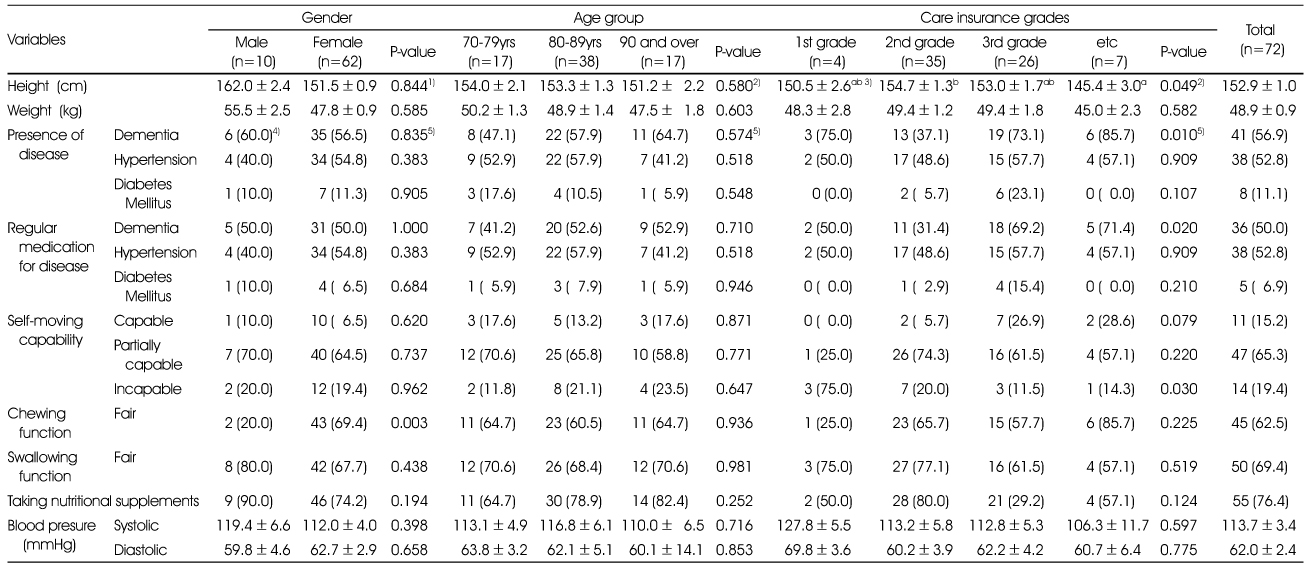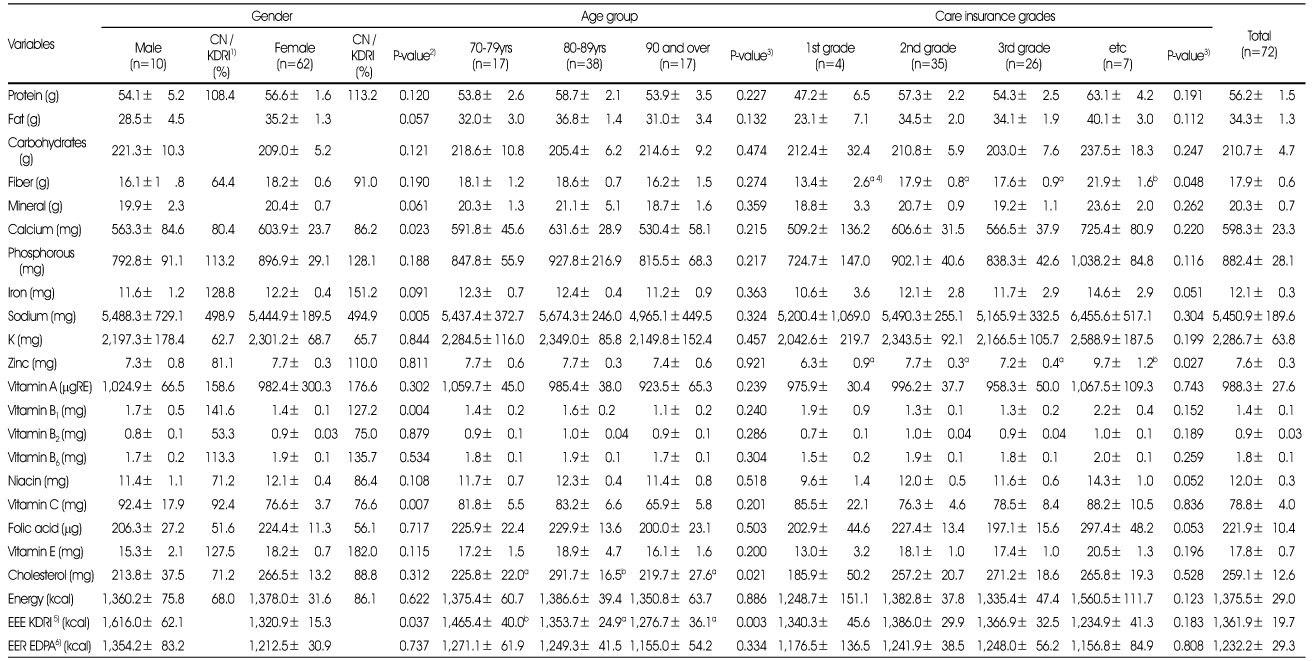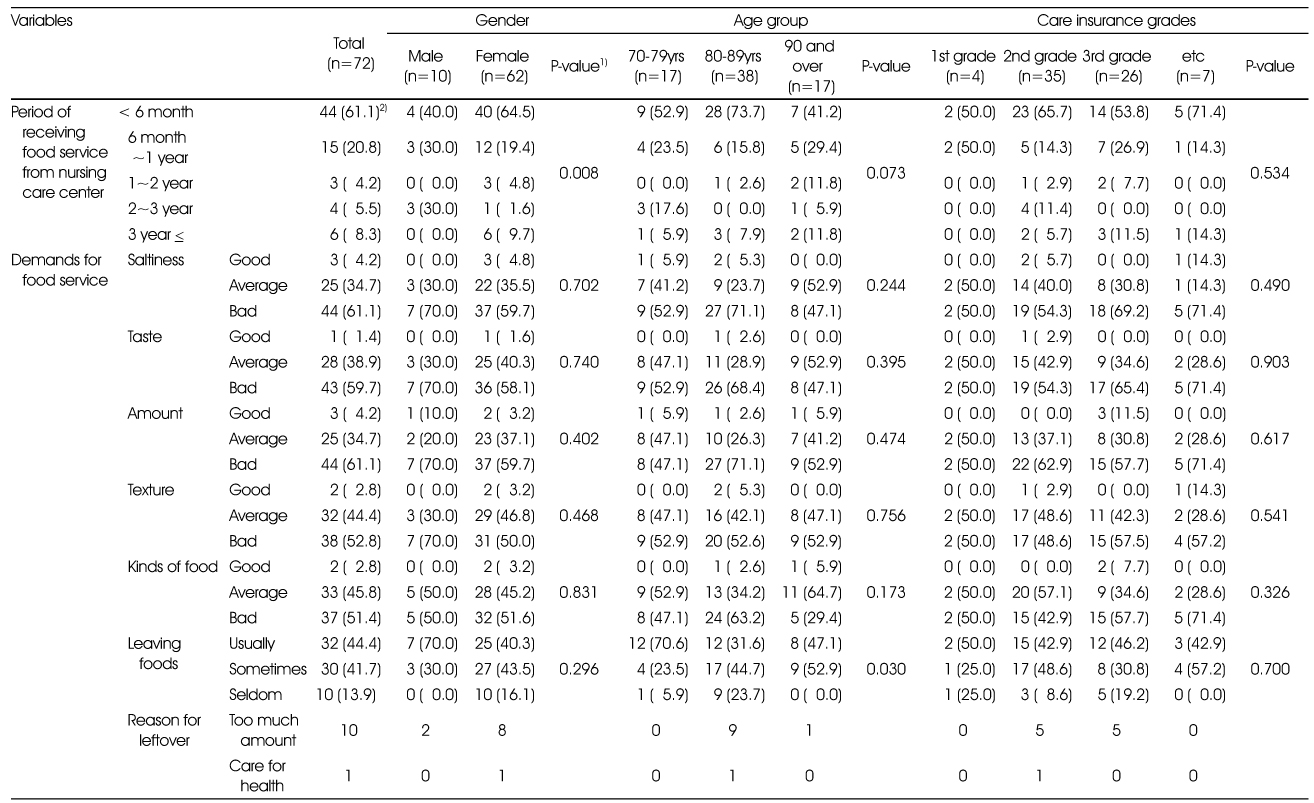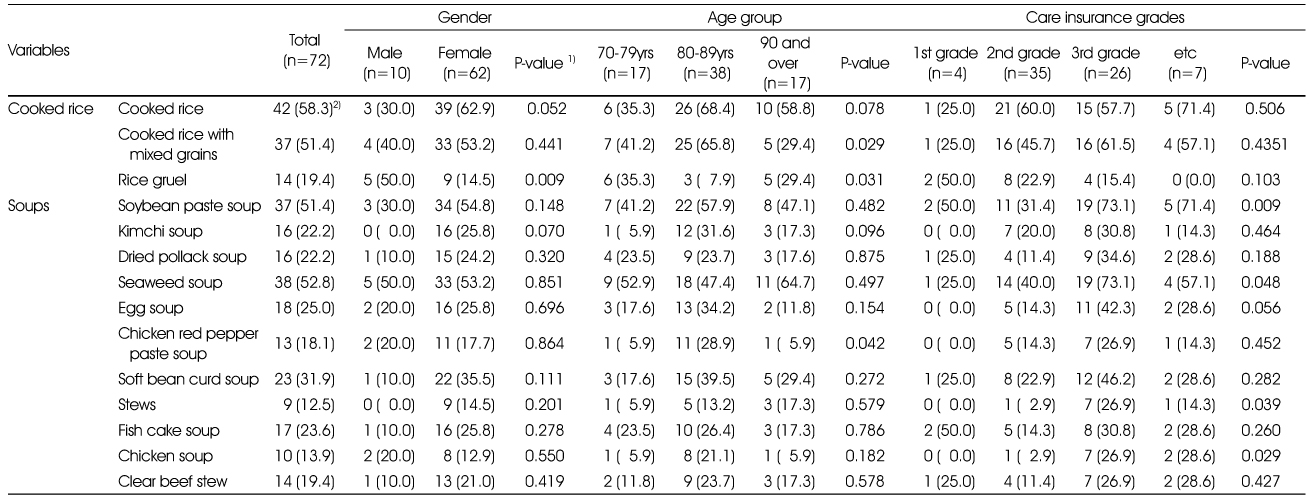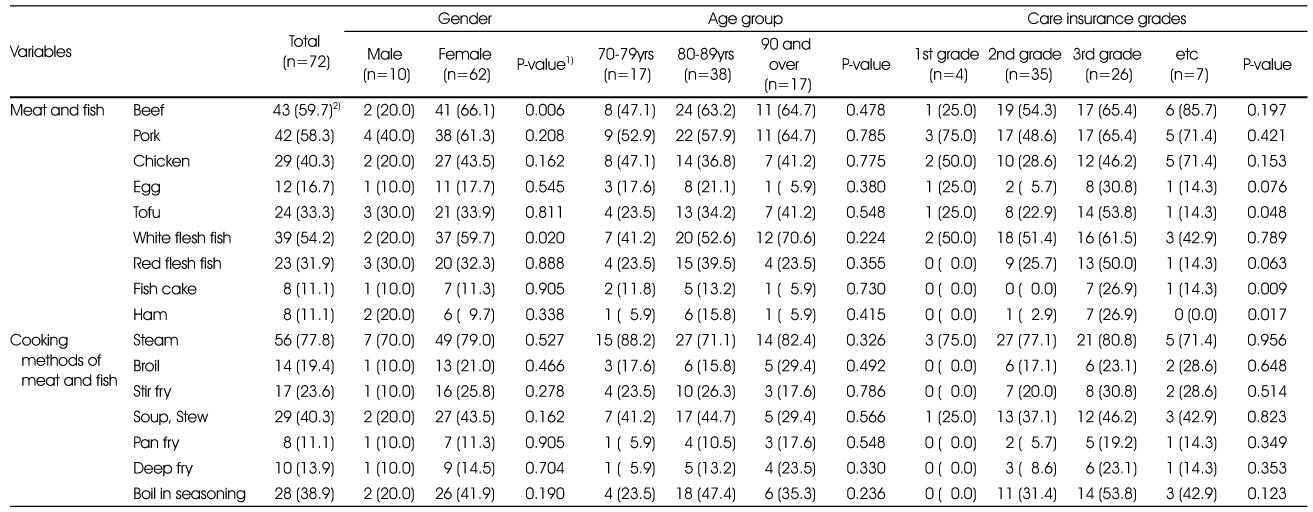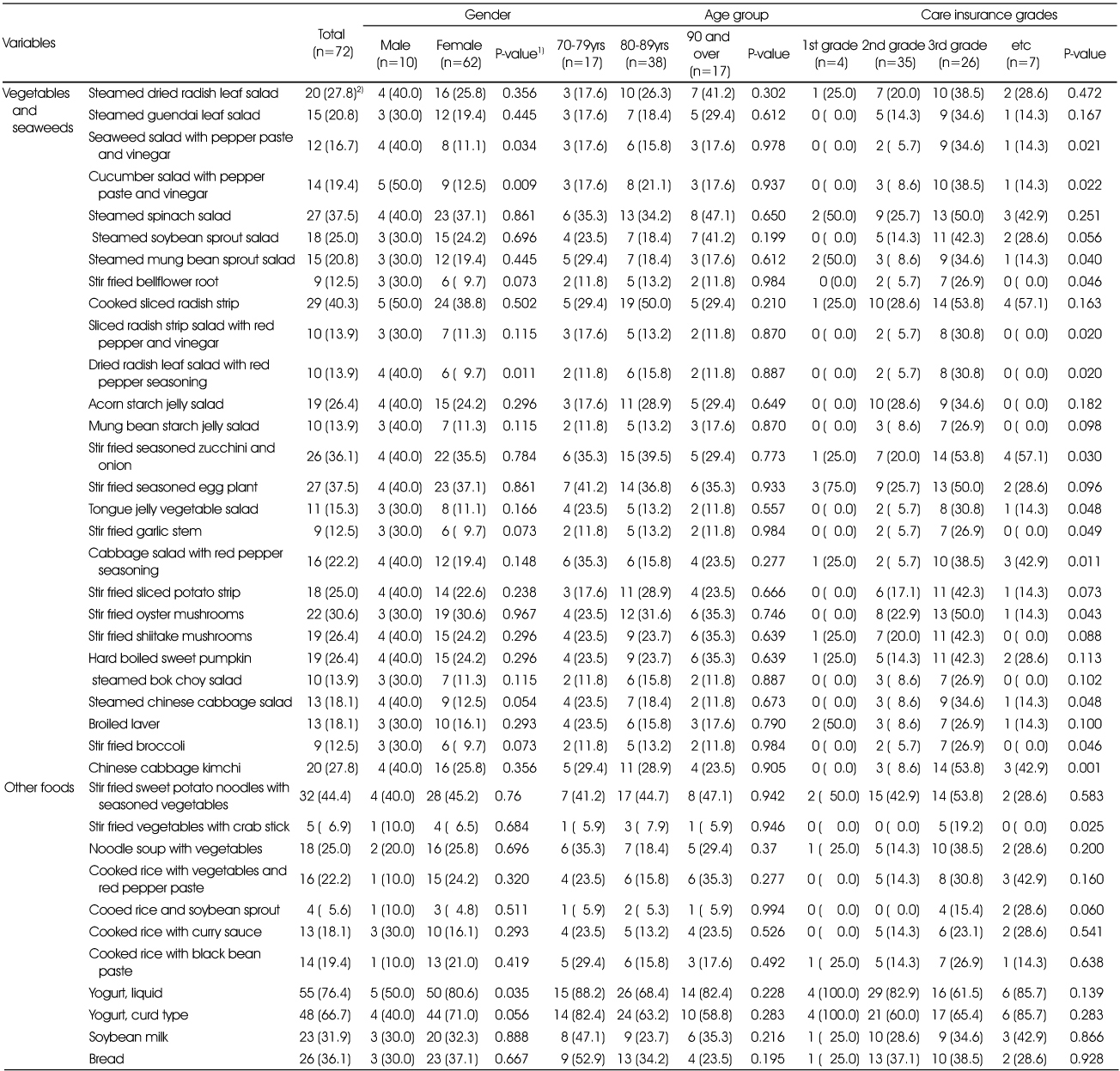References
1. Statistics Korea. Annual report on the Statistics for elderly [internet] 2014. cited 2014 Jun 19. Available from:
http://kostat.go.kr.
2. Shahar D, Shai I, Vardi H, Fraser D. Dietary intake and eating patterns of elderly people in Israel: who is at nutritional risk? Eur J Clin Nutr 2003;57(1):18–25.
3. Kwak KS, Bae YJ, Kim MH. Nutritional status and dietary quality in the low-income elderly residing at home or in health care facilities. J Korean Diet Assoc 2008;14(4):337–350.
4. Ministry of Health and Welfare, Korea center for disease control and prevention. 2013 Korea national health and nutrition examination survey [internet] 2014. cited 2014 Dec 22. Available from:
http://knhanes.cdc.go.kr.
5. Long Term Care Insurance. Insurance benefit in-home service [internet] 2010. cited 2010 Aug 22. Available from:
http://www.longtermcare.or.kr.
6. Sunwoo D. An improvement plan for the government policy on long-term care insurance. Health Welf Policy Forum 2010;10(168):16–24.
7. Han HY. A study on the satisfaction degree of elderly care facilities and long-term care service -focused on Seoul, Incheon and Gyeonggi. [master's thesis] Hanyang University; 2013.
9. Kim WY, Ahn SY, Song YS. The nutritional status and intervention effects of multivitamin-mineral supplementation in nursing-home residents in Korea. Korean J Community Nutr 2000;5(2):201–207.
10. Yoon MO, Moon HK, Jeon JY, Sohn CM. Nutritional management by dietitian at elderly nursing homes in Gyeonggido. J Korean Diet Assoc 2013;19(4):400–415.
11. Japan Ministry of Health, Labour and Welfare. Long-term care, health and welfare services for the elderly [internet] 2012. cited 2012 Jan 30. Available from:
http://www.mhlw.go.jp.
12. National Institute on Aging. Health eating after 50 [internet] 2012. cited 2012 Jan 30. Available from:
http://www.nia.nih.gov.
13. Han HK, Choi SS, Kim MW, Lee SD. Food habits and nutritional status of the long-lived elderly people in Ganghwagun area. Korean J Community Nutr 2005;10(1):101–110.
14. Yoon HJ, Lee HK, Lee SK. The health status and nutrient intakes of elderly female in Daegu area. Korean J Community Nutr 2007;12(1):50–57.
15. Lee MS. Nutritional status of the oldest-elderly population in Sunchang county. Korean J Community Nutr 2009;14(3):255–265.
16. Kwak CS, Cho JH, Yon M, Park SC. Anthropometric index, dietary habits and nutrient intake of the oldest-old population aged 95 and over living in Seoul. Korean J Community Nutr 2012;17(5):603–622.
17. Korea Health Industry Development Institute (KHIDI), Nongshim. In-depth Analsyis on Eating Habits and Health Status of Present and Future Consumer - based on Korea National Health and Nutrition Examination Survey (KNHANES IV and V) data KHIDI; 2012. Dec. Report No. Private Sector-Nutrition-2012-67.
18. Lee KH, Park JR, Seo JS. Nutritional status of the elderly living in a private silver town of Busan metropolitan city, Korea. J Korean Soc Food Sci Nutr 2007;36(10):1293–1299.
19. Kwon JS, Kim K, Kim HK. A study on application of food photographs for estimating individuals dietary intake. Korean J Community Nutr 2010;15(6):760–775.
20. Korean Nutrition Society. Dietary reference intake for Koreans 1st revisionth ed. Seoul: The Korean Nutrition Society; 2010. p. xxv–xxix.
p. 30–32.
21. Choi HM. Nutrition 3rd edth ed. Paju: Kyomunsa; 2006. p. 176–177.
p. 584–586.
22. Suh HJ, Lee Y, Jang Y, Kim B, Lee H, Kim CI. Current status and management of congregate meal service program for the elderly at community centers. J Korean Diet Assoc 2004;10(3):333–344.
24. Cho KJ, Han DH. Study on food habits of the elderly in institution. J Korean Soc Food Sci Nutr 1998;27(4):756–764.
25. Roberts SB. Effects of aging on energy requirements and the control of food intake in men. J Gerontol A Biol Sci Med Sci 1995;50(Spec No):101–106.
26. Volkert D, Kreuel K, Heseker H, Stehle P. Energy and nutrient intake of young-old, old-old and very-old elderly in Germany. Eur J Clin Nutr 2004;58(8):1190–1200.
27. Bell J, Whiting SJ. Elderly women need dietary protein to maintain bone mass. Nutr Rev 2002;60(10):337–341.
28. Chobanian AV, Hill M. National heart, lung, and blood institute workshop on sodium and blood pressure: A critical review of current scientific evidence. Hypertension 2000;35(4):858–863.
29. Ahn SH, Kim HK, Kim KM, Yoon JS, Kwon JS. Development of nutrition education program for consumers to reduce sodium intake applying the social cognitive theory: based on focus group interviews. Korean J Community Nutr 2014;19(4):342–360.
30. He FJ, Macgregor GA. Reducing population salt intake worldwide: from evidence to implementation. Prog Cardiovasc Dis 2010;52(5):363–382.
31. Park YS, Son SM, Lim WJ, Kim SB, Chung YS. Comparison of dietary behaviors related to sodium intake by gender and age. Korean J Community Nutr 2008;13(1):1–12.
32. Catholic University of Korea & Management Center for Health promotion. Integrated health promotion service in community health center 2010. p. 22–48.
33. Jimenez-Redondo S, Beltrán de Miguel B, Gavidia Banegas J, Guzmán Mercedes L, Gomez-Pavon J, Cuadrado Vives C. Influence of nutritional status on health-related quality of life of non-institutionalized older people. J Nutr Health Aging 2014;18(4):359–364.
34. Lee HS. The Factors Influencing Health-Related Quality of Life in the Elderly: Focused on the General Characteristics, Health Habits, Mental Health, Chronic Diseases, and Nutrient Intake Status: Data from the Fifth Korea National Health and Nutrition Examination. Korean J Community Nutr 2014;19(5):479–489.
35. Chang YK, Park HR, Byun KW, Kwon JS. Basic nutrition Seoul: Kyomunsa; 2006. p. 198–288.
36. Kim HY, Lee SH, Lim YL. A study on the dietary and nutrition intake of the elderly resident in nursing home. J Korea Goron Soc 1995;15(2):69–83.
37. Seo S, Yun N. Foodservice management and food safety knowledge and practices of employees in elderly welfare facilities. J Korean Diet Assoc 2011;17(3):287–301.
38. Hong SY, Seo S. Job performance frequency and the training needs of dieticians in elderly healthcare facilities. J Korean Diet Assoc 2010;16(2):160–177.
39. Wouters-Wesseling W, Wouters AE, Kleijer CN, Bindels JG, de Groot CP, van Staveren WA. Study of the effects of a liquid nutrition supplement on the nutritional status of psycho-geriatric nursing home patients. Eur J Clin Nutr 2002;56(3):245–251.
40. Nijs KA, de Graaf C, Kok FJ, van Staveren WA. Effect of family style mealtimes on quality of life, physical performance, and body weight of nursing home residents: cluster randomised controlled trial. BMJ 2006;332(7551):1180–1184.

